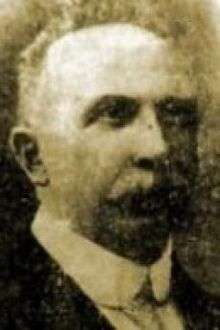Giacomo Gorrini

Giacomo Gorrini (1859, Molino dei Torti - 31 October 1950, Rome) was an Italian diplomat.
In 1886 he became the first director of the Italian Foreign Minister Archives. In the years 1911-1915 he served as Italian Consul in the provinces of Trabzon, Erzurum, Van, Bitlis, and Sivas. He was eyewitness to the massacres perpetrated by the Young Turks. He had to leave his office in August 1915, when Italy declared war on Turkey. His interview by, il Messaggero, called for, "il più risoluta riprovazione e la vendetta dell'intera Cristianità"(forceful condemnation and vengeance by the whole of Christendom).[1]
During World War I he openly denounced the Armenian genocide through press articles and interviews and he didn't hesitate to describe the horror the Turkish rulers perpetrated against the Armenians. He said if everyone had seen what he had, the condemnation of those acts would have been universal especially on the side of the Christian powers. He was in touch with American Ambassador Morgenthau and the Vatican's Angelo Dolci, and this way he managed to save 50,000 Armenians from deportation and mass murder. Gorrini, who witnessed the drowning of thousands of Armenians, said "I saw thousands of innocent women and children placed on boats which were capsized in the Black Sea".[2] Others have provided similar testimonies including Oscar S. Heizer, the American consul at Trabzon, who reported that "many of the children were loaded into boats and taken out to sea and thrown overboard."[3] Hafiz Mehmet, a deputy from Trabzon, also testified in a 21 December 1918 session of the Turkish Parliament that "Under the pretext of sending off to Samsun, another port city on the Black Sea [about 255 km west of Trabzon], the district's governor loaded the Armenians into barges and had them thrown overboard."[4][5] Gorrini believed that the orders came from the Central Government, and reported:
The local authorities, and indeed the Moslem population in general, tried to resist, to mitigate it, to make omissions, to hush it up. But the orders of the Central Government were categorically confirmed, and all were compelled to resign themselves and obey. It was a real extermination and slaughter of the innocents, an unheard-of thing, a black page stained with the flagrant violation of the most sacred rights of humanity ...There were about 14,000 Armenians at Trebizond — Gregorians, Catholics, and Protestants. They had never caused disorders or given occasion for collective measures of police. When I left Trebizond, not a hundred of them remained.[6]
From 1918 to 1920 he was the only Western Ambassador to the Republic of Ararat. He then tried to obtain the intervention of two Italian warships in favor of the Armenians, but the newly appointed Italian Foreign Minister prevented him from doing so.
In 1920 Gorrini took a stance in favor of the Italian support to the independence of Armenia in a Memorandum attached to the Treaty of Sèvres. There he wrote: "If we don't solve the problem of Armenia, even partially, peace will be periodically disturbed throughout the world". In the following 20 years he helped many Armenians to flee Turkey heading to Italy. He also personally rescued an Armenian girl who would stay with him till his death. In 1940 Giacomo Gorrini published a book in which he stated that the Armenians should regain the land they had lost as soon as possible. This would include Kars, Van, Ardahan and others.
References
- ↑ Symbolism, Violence and the Destruction of Religious Communities in the Russian and Ottoman Empires c.1870-1923, Cathie Carmichael, Can Faiths Make Peace?: Holy Wars and the Resolution of Religious Conflicts, ed. Philip Broadhead, Damien Keown, (I.B. Tauris, 2007), 77.
- ↑ "Turks Slay 14,000 In One Massacre". Toronto Globe. 26 August 1915. p. 1.
- ↑ Kiernan, Ben (2007). Blood and soil : genocide and extermination from Carthage to Darfur. New Haven, Conn.: Yale University Press. p. 412. ISBN 0-300-10098-1.
- ↑ Winter, J. M. (2003). America and the Armenian Genocide of 1915. Cambridge University Press. p. 81. ISBN 978-0-511-16382-1.
- ↑ Akcam, Taner (10 Feb 2007). "My Turkishness in Revolt". The Armenian Reporter. pp. 1–2.
- ↑ Walker, Christopher (1980). Armenia, the survival of a nation. Croom Helm. p. 216.
See also
External links
- Gorrini on Gardens of the Righteous Worldwide - Gariwo
- Giacomo Gorrini in the Italian State Archives
| Wikimedia Commons has media related to Giacomo Gorrini. |
|